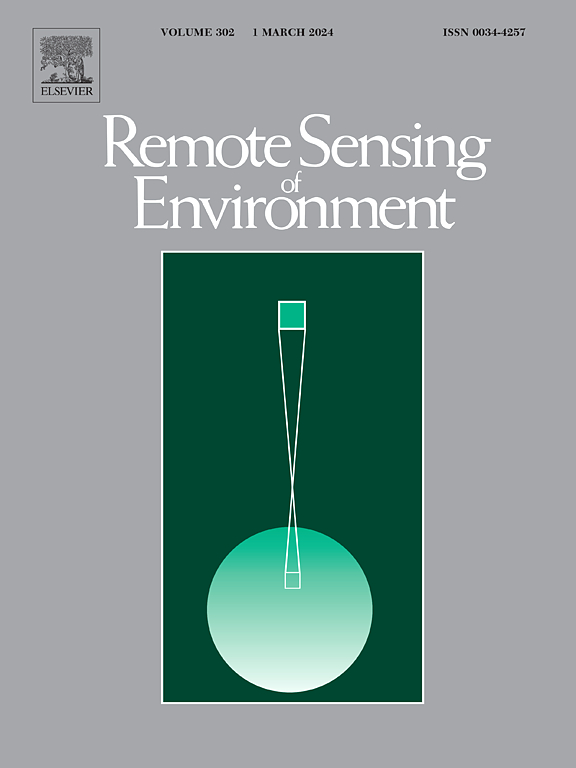Impact of data density and endmember definitions on long-term trends in ground cover fractions across European grasslands
IF 11.1
1区 地球科学
Q1 ENVIRONMENTAL SCIENCES
引用次数: 0
Abstract
Long-term monitoring of grasslands is pivotal for ensuring continuity of many environmental services and for supporting food security and environmental modeling. Remote sensing provides an irreplaceable source of information for studying changes in grasslands. Specifically, Spectral Mixture Analysis (SMA) allows for quantification of physically meaningful ground cover fractions of grassland ecosystems (i.e., green vegetation, non-photosynthetic vegetation, and soil), which is crucial for our understanding of change processes and their drivers. However, although popular due to straightforward implementation and low computational cost, ‘classical’ SMA relies on a single endmember definition for each targeted ground cover component, thus offering limited suitability and generalization capability for heterogeneous landscapes. Furthermore, the impact of irregular data density on SMA-based long-term trends in grassland ground cover has also not yet been critically addressed.
We conducted a systematic assessment of i) the impact of data density on long-term trends in ground cover fractions in grasslands; and ii) the effect of endmember definition used in ‘classical’ SMA on pixel- and map-level trends of grassland ground cover fractions. We performed our study for 13 sites across European grasslands and derived the trends based on the Cumulative Endmember Fractions calculated from monthly composites. We compared three different data density scenarios, i.e., 1984–2021 Landsat data record as is, 1984–2021 Landsat data record with the monthly probability of data after 2014 adjusted to the pre-2014 levels, and the combined 1984–2021 Landsat and 2015–2021 Sentinel-2 datasets. For each site we ran SMA using a selection of site-specific and generalized endmembers, and compared the pixel- and map-level trends. Our results indicated no significant impact of varying data density on the long-term trends from Cumulative Endmember Fractions in European grasslands. Conversely, the use of different endmember definitions led in some regions to significantly different pixel- and map-level long-term trends raising questions about the suitability of the ‘classical’ SMA for complex landscapes and large territories. Therefore, we caution against using the ‘classical’ SMA for remote-sensing-based applications across broader scales or in heterogenous landscapes, particularly for trend analyses, as the results may lead to erroneous conclusions.
数据密度和端元定义对欧洲草原地表覆盖组分长期趋势的影响
对草原进行长期监测对于确保许多环境服务的连续性以及支持粮食安全和环境建模至关重要。遥感为研究草原的变化提供了不可替代的信息来源。具体来说,光谱混杂分析(SMA)可以量化草原生态系统中具有物理意义的地面覆盖部分(即绿色植被、非光合植被和土壤),这对我们了解变化过程及其驱动因素至关重要。然而,尽管 "经典 "SMA 因实施简单、计算成本低廉而广受欢迎,但它依赖于对每个目标地表植被组分的单一内元定义,因此对异质景观的适用性和概括能力有限。此外,不规则数据密度对基于 SMA 的草地地被长期趋势的影响也尚未得到认真研究。我们对以下两个方面进行了系统评估:i) 数据密度对草地地被分部长期趋势的影响;ii) "经典 "SMA 中使用的内元定义对草地地被分部像素级和地图级趋势的影响。我们对欧洲草原上的 13 个地点进行了研究,并根据月度复合图计算出的累积内含物分数得出了趋势。我们比较了三种不同的数据密度方案,即 1984-2021 年陆地卫星数据记录的原样、将 2014 年之后的每月数据概率调整为 2014 年之前水平的 1984-2021 年陆地卫星数据记录,以及 1984-2021 年陆地卫星和 2015-2021 年哨兵-2 数据集的组合。对于每个站点,我们使用特定站点和广义内含物的选择来运行 SMA,并比较像素和地图级别的趋势。结果表明,不同的数据密度对欧洲草地累积内含物分数的长期趋势没有明显影响。相反,在某些地区,使用不同的末级成员定义会导致像素级和地图级的长期趋势出现显著差异,这使人们对 "经典 "SMA 是否适用于复杂地貌和大面积区域产生了疑问。因此,我们告诫大家不要将 "经典 "SMA 应用于更大范围或异质地貌的遥感应用,尤其是趋势分析,因为其结果可能会导致错误的结论。
本文章由计算机程序翻译,如有差异,请以英文原文为准。
求助全文
约1分钟内获得全文
求助全文
来源期刊

Remote Sensing of Environment
环境科学-成像科学与照相技术
CiteScore
25.10
自引率
8.90%
发文量
455
审稿时长
53 days
期刊介绍:
Remote Sensing of Environment (RSE) serves the Earth observation community by disseminating results on the theory, science, applications, and technology that contribute to advancing the field of remote sensing. With a thoroughly interdisciplinary approach, RSE encompasses terrestrial, oceanic, and atmospheric sensing.
The journal emphasizes biophysical and quantitative approaches to remote sensing at local to global scales, covering a diverse range of applications and techniques.
RSE serves as a vital platform for the exchange of knowledge and advancements in the dynamic field of remote sensing.
 求助内容:
求助内容: 应助结果提醒方式:
应助结果提醒方式:


